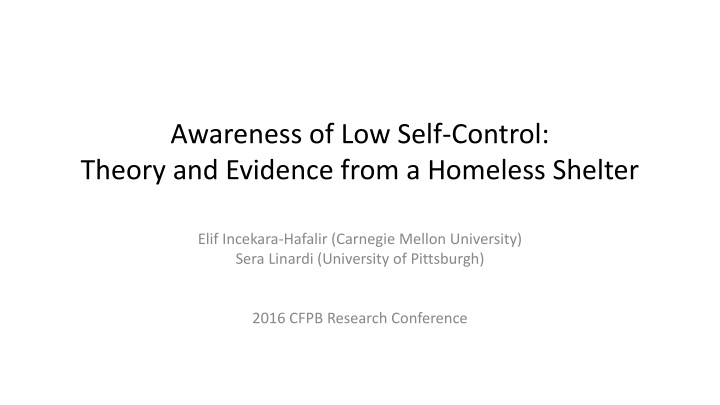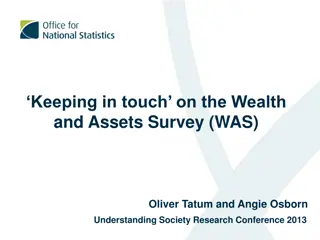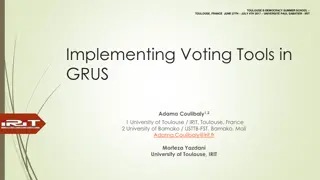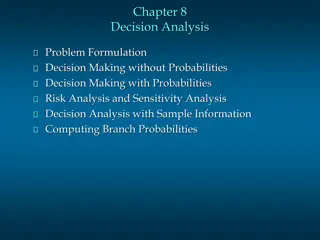Investigating Survey Measures of Self-Control and Awareness in Financial Decision Making
Survey measures of self-control play a crucial role in understanding individuals' ability to resist temptations and make optimal financial decisions. This study explores the Expected Deviation (ED) measure as a potential indicator of both self-control and awareness, using evidence from a homeless shelter setting. Findings suggest a positive correlation between ED and savings, indicating the relevance of capturing awareness in addition to self-control in behavioral research.
Download Presentation

Please find below an Image/Link to download the presentation.
The content on the website is provided AS IS for your information and personal use only. It may not be sold, licensed, or shared on other websites without obtaining consent from the author.If you encounter any issues during the download, it is possible that the publisher has removed the file from their server.
You are allowed to download the files provided on this website for personal or commercial use, subject to the condition that they are used lawfully. All files are the property of their respective owners.
The content on the website is provided AS IS for your information and personal use only. It may not be sold, licensed, or shared on other websites without obtaining consent from the author.
E N D
Presentation Transcript
Awareness of Low Self-Control: Theory and Evidence from a Homeless Shelter Elif Incekara-Hafalir (Carnegie Mellon University) Sera Linardi (University of Pittsburgh) 2016 CFPB Research Conference
Survey measures of self-control: How informative are they? Self-control, the ability to follow one s ideal plan depite of temptations, is a central concept in behavioral science (Laibson (1997), Gul and Pesendorfer (2001)). Important in financial decision making (Bryan et al. 2010) Measuring self-control accurately is crucial Incentivized experiments Surveys
Survey measures of self-control: Are they measuring awareness in addition to self-control? Self Control Scale (Tangney, et al. 2004) I m good at resisting temptation Expected Deviation (Ameriks et al 2007) Ideal behavior: How much would you ideally like to save? Predicted behavior: How much do you think you would save if you were to give into your temptation? Ideal=$100, Predicted=$99 Expected Deviation (ED)=$1
We investigate a specific survey measure of self-control: Expected Deviation (ED) Expected Deviation (ED)= ideal behavior-predicted behavior Evidence on ED so far: ED is negatively correlated with desirable outcome (such as savings) This is consistent with this survey measure capturing self-control problem What if ED captures awareness of self-control as well? Theoretically explore how Expected Deviation (ED) and savings change with self-control and awareness Correlation between ED and savings depends on the study population Empirically explore a setting where awareness is likely to matter The commitment savings of homeless shelter residents ED is positively correlated with savings Not consistent with the idea that ED captures self-control alone But, meaningful if ED captures awareness in addition to self-control
Self-control and Awareness We use well-known ?- model (Laibson (1997), O Donoghue & Rabin (2001, 2003)) Actual: 1,??,??2, Believes: 1,? ?,? ?2, ??? 0 ? ? 1 We introduce a parameter for awareness of self-control (?) By reparametrizing ? = 1 ? 1 ? ??? 0 ? 1 Awareness of self-control (?): captures the accuracy of one s perception of self-control
Expected Deviation (ED) ED=Ideal saving-Predicted saving ? ?? ?? < 0 ? ?? ?? ? ?? > 0 ??? ?? < 0
Savings without available commitment device Savings without commitment, ?? ? ?? ??> 0 ? ?? ??= 0
A high awareness population varying in self-control Strong negative correlation A high self-control population varying in awareness No correlation A low self-control population varying in awareness No correlation A low awareness population varying in self-control Weak negative correlation
Commitment Devices We model Withdrawal-side commitments (e.g. 529 education account, the SEED commitment savings account (Ashraf et al. (2006b), physical lockboxes (Shipton, 1992)) Restrict the withdrawal Requires an initial costly effort (E.g. get a friend to walk me to the lockbox everyday after work to deposit money) People spend this effort only if they think that it is needed
Savings with commitment At low awareness, Savings are identical to the savings w/o commitment As awareness increases, savings starts to increase Start spending effort Awareness affects savings more for low self-control populations In general, self-control increases savings
A high awareness population varying in self-control Weak negative correlation A high self-control population varying in awareness Weak positive correlation A low self-control population varying in awareness Strong positive correlation A low awareness population varying in self-control Weak negative correlation
Setting: Homeless shelter We worked with Central Arizona Shelter Services Mean Std. Dev. Age Female Education Black Reason for homelessness: addiction Reason for homelessness: jail High school dropout First time homeless Month homeless 41.66 0.16 12.01 0.38 0.37 0.20 0.37 0.44 11.68 10.45 0.37 2.27 0.49 0.48 0.40 0.48 0.50 12.70 ? >0.85 for standard populations (Frederick et al (2002) ) ?=0.6 estimated for a subset of this population (Linardi & Tanaka (2013))
Setting: Homeless shelter Shelter setting Shelter covers almost all residential expenses (room, board) Residents need to report income & savings to the financial manager. Residents save in shelter lockbox, can take it out when they leave shelter. $1000/month income expectation (Linardi and Tanaka, 2013) ED survey at the shelter Ideal: How much would you ideally like to save in the next 4 weeks? ($776.15) Predicted: How much do you think you will actually save in the next 4 weeks? ($650.48) 9% ED<0, 35% ED=0, 56% ED>0, average ED $115 (15%) Income much lower than expected (economic crisis in 2009) Among those who earn average earning is $473.37 and saving is $301. Reporting rate initially low Residents making $0 income did not make reports at first. Overall 76% report Shelter coded missing reports as $0 income and $0 savings.
(1) (2) (3) ED (5) (6) Ideal saving ($100) Predicted saving ($100) Variables ($100) Income Savings Age -0.01 (0.05) -4.28** (2.09) -2.15* (1.10) 0.11 (0.22) 4.95* (2.77) 0.01 (0.01) -1.61 (1.88) -1.40 (1.25) 0.02 (0.02) 0.04 (0.05) -4.03* (2.06) -1.97 (1.24) 0.05 (0.26) 5.02* (2.89) 0.01 (0.01) -2.44 (1.88) -1.05 (1.30) 0.02 (0.02) -0.05* (0.03) -0.25 (0.90) -0.18 (0.78) 0.06 (0.20) -0.07 (0.79) -0.00 (0.00) 0.83 (0.78) -0.35 (0.92) -0.00 (0.01) 9.25*** (3.27) -66.54 (76.56) -146.67** (67.38) 2.49 (19.31) 141.90* (77.30) -0.00 (0.09) -28.86 (101.72) 12.53 (100.98) -0.87 (1.07) -0.95 (0.81) -17.83 (19.08) -24.55 (21.26) 6.47 (5.98) -8.65 (18.66) 0.02 (0.02) -9.77 (19.94) 18.51 (26.77) 0.28 (0.26) 0.56*** (0.07) Female Black Education First time homeless Months homeless Reason: addiction Reason: jail Days since employed income Time control
The effect of ED (1) (2) (3) Report Income Savings VARIABLES ED -0.01 (0.02) -7.37 (11.94) 7.20* (3.79) 0.57*** (0.06) 95 0.84 Income Observations AdjR2 95 95 0.277 -0.01 Robust standard errors in parentheses. *** p<0.01, ** p<0.05, * p<0.1, +p<0.11. Time FE included.
Heckman Selection Model (1) (2) (3) (4) (5) (6) (7) (8) VARIABLES Saving Selection Saving Selection Saving Selection Saving Selection ED 9.82** (4.17) -0.03 (0.05) Ideal savings 3.50 (2.57) 0.01 (0.02) 10.90** (4.39) -8.86** (4.31) 0.56*** (0.03) -0.02 (0.05) 0.03 (0.05) Predicted savings -0.08 (2.56) 0.56*** (0.03) 0.01 (0.02) 0.56*** (0.03) Income 0.56*** (0.03) Summer 2009 -1.63*** (0.34) 1.31 (0.23) -1.72*** (0.36) 1.22*** (0.26) -1.72*** (0.35) 1.21*** (0.25) -1.69*** (0.36) 1.24*** (0.27) Constant 34.77 (18.73) 18.53 (26.15) 43.14* (24.98) 20.98 (25.55) Observations 95 95 95 95 Robust standard errors in parentheses. *** p<0.01, ** p<0.05, * p<0.1, +p<0.11. Time FE included.
Heckman Selection Model (1) (2) (3) (4) (5) (6) (7) (8) VARIABLES Saving Selection Saving Selection Saving Selection Saving Selection ED 9.82** (4.17) -0.03 (0.05) Ideal savings 3.50 (2.57) 0.01 (0.02) 10.90** (4.39) -8.86** (4.31) 0.56*** (0.03) -0.02 (0.05) 0.03 (0.05) Predicted savings -0.08 (2.56) 0.56*** (0.03) 0.01 (0.02) 0.56*** (0.03) Income 0.56*** (0.03) Summer 2009 -1.63*** (0.34) 1.31 (0.23) -1.72*** (0.36) 1.22*** (0.26) -1.72*** (0.35) 1.21*** (0.25) -1.69*** (0.36) 1.24*** (0.27) Constant 34.77 (18.73) 18.53 (26.15) 43.14* (24.98) 20.98 (25.55) Observations 95 95 95 95 Robust standard errors in parentheses. *** p<0.01, ** p<0.05, * p<0.1, +p<0.11. Time FE included.
Heterogeneity Effect of $100 of ED on additional savings ($) Coef. Std. Err. P>z Panel A: Not homeless due to addiction Homeless due to addiction 4.16 11.3 9.2 4.68 0.65 0.02 Panel B: Did not drop out of high school Dropped out of high school 9.39 11.49 5.82 5.99 0.11 0.06 Panel C: Not homeless due to incarceration Homeless due to incarceration 5.09 18.89 3.41 10.01 0.14 0.07
Conclusion Positive correlation between a survey measure of self-control and savings in a homeless shelter with lockbox. The correlation is stronger among those who have worse self- control problem This suggest that the survey might be capturing awareness in addition to self-control We suggest more tests of self-control surveys among non- standard populations























